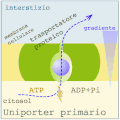Uniporter
Uniporter[edit]
A uniporter is a type of membrane transport protein that facilitates the movement of a single type of molecule or ion across a cell membrane. Unlike other transport proteins, uniporters do not couple the transport of the molecule to the movement of another molecule or ion. This process is known as facilitated diffusion, and it allows substances to move down their concentration gradient without the input of energy.

Mechanism[edit]
Uniporters operate by binding to the specific molecule they transport, undergoing a conformational change, and releasing the molecule on the other side of the membrane. This process is driven by the concentration gradient of the molecule, meaning that the molecule moves from an area of higher concentration to an area of lower concentration.

Examples[edit]
One well-known example of a uniporter is the glucose transporter found in the membranes of many cells. This transporter allows glucose to enter the cell where it can be used for energy production.

Structure[edit]
Uniporters are typically composed of multiple transmembrane domains that form a channel or pore through which the molecule can pass. The structure of these proteins is crucial for their specificity and function.

Function in Cells[edit]
Uniporters play a critical role in maintaining cellular homeostasis by regulating the internal concentration of various molecules. They are involved in numerous physiological processes, including nutrient uptake, ion balance, and signal transduction.
Related Transport Mechanisms[edit]
Uniporters are one of several types of transport proteins. Others include:
- Symporters, which transport two different molecules in the same direction.
- Antiporters, which transport two different molecules in opposite directions.
Related Pages[edit]
References[edit]
- Alberts, B., Johnson, A., Lewis, J., Raff, M., Roberts, K., & Walter, P. (2002). Molecular Biology of the Cell. 4th edition. New York: Garland Science.
- Lodish, H., Berk, A., Zipursky, S. L., Matsudaira, P., Baltimore, D., & Darnell, J. (2000). Molecular Cell Biology. 4th edition. New York: W. H. Freeman.
-
Uniporter
-
Facilitated diffusion in cell membrane
-
Glucose-6-phosphatase system
-
Protein SLC3A2 structure
-
Uniporter
Ad. Transform your life with W8MD's Budget GLP-1 injections from $75


W8MD offers a medical weight loss program to lose weight in Philadelphia. Our physician-supervised medical weight loss provides:
- Weight loss injections in NYC (generic and brand names):
- Zepbound / Mounjaro, Wegovy / Ozempic, Saxenda
- Most insurances accepted or discounted self-pay rates. We will obtain insurance prior authorizations if needed.
- Generic GLP1 weight loss injections from $75 for the starting dose.
- Also offer prescription weight loss medications including Phentermine, Qsymia, Diethylpropion, Contrave etc.
NYC weight loss doctor appointmentsNYC weight loss doctor appointments
Start your NYC weight loss journey today at our NYC medical weight loss and Philadelphia medical weight loss clinics.
- Call 718-946-5500 to lose weight in NYC or for medical weight loss in Philadelphia 215-676-2334.
- Tags:NYC medical weight loss, Philadelphia lose weight Zepbound NYC, Budget GLP1 weight loss injections, Wegovy Philadelphia, Wegovy NYC, Philadelphia medical weight loss, Brookly weight loss and Wegovy NYC
|
WikiMD's Wellness Encyclopedia |
| Let Food Be Thy Medicine Medicine Thy Food - Hippocrates |
Medical Disclaimer: WikiMD is not a substitute for professional medical advice. The information on WikiMD is provided as an information resource only, may be incorrect, outdated or misleading, and is not to be used or relied on for any diagnostic or treatment purposes. Please consult your health care provider before making any healthcare decisions or for guidance about a specific medical condition. WikiMD expressly disclaims responsibility, and shall have no liability, for any damages, loss, injury, or liability whatsoever suffered as a result of your reliance on the information contained in this site. By visiting this site you agree to the foregoing terms and conditions, which may from time to time be changed or supplemented by WikiMD. If you do not agree to the foregoing terms and conditions, you should not enter or use this site. See full disclaimer.
Credits:Most images are courtesy of Wikimedia commons, and templates, categories Wikipedia, licensed under CC BY SA or similar.
Translate this page: - East Asian
中文,
日本,
한국어,
South Asian
हिन्दी,
தமிழ்,
తెలుగు,
Urdu,
ಕನ್ನಡ,
Southeast Asian
Indonesian,
Vietnamese,
Thai,
မြန်မာဘာသာ,
বাংলা
European
español,
Deutsch,
français,
Greek,
português do Brasil,
polski,
română,
русский,
Nederlands,
norsk,
svenska,
suomi,
Italian
Middle Eastern & African
عربى,
Turkish,
Persian,
Hebrew,
Afrikaans,
isiZulu,
Kiswahili,
Other
Bulgarian,
Hungarian,
Czech,
Swedish,
മലയാളം,
मराठी,
ਪੰਜਾਬੀ,
ગુજરાતી,
Portuguese,
Ukrainian




